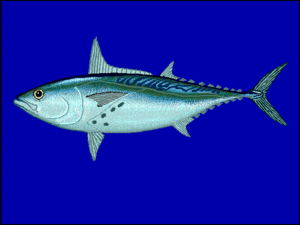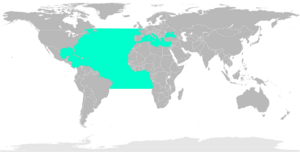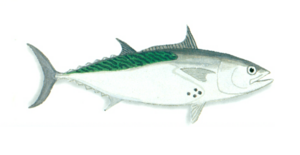Little tunny facts for kids
Quick facts for kids Little tunny |
|
|---|---|
 |
|
| Conservation status | |
| Scientific classification | |
 |
|
| Range of the little tunny | |
| Synonyms | |
|
The little tunny (Euthynnus alletteratus) is a type of tuna that lives in the ocean. People also call it the false albacore, little tuna, or bonita. You can find this fish in the Atlantic Ocean, the Mediterranean Sea, and the Black Sea. In the western Atlantic, it swims from Brazil all the way up to the New England states in the USA.
The little tunny is a pelagic fish, meaning it lives in the open ocean. It can be found both far from shore and closer to the coast. It is known as a highly migratory species, which means it travels long distances. You can easily spot a little tunny by the "worm-like" wavy lines on its back. It also has dark spots between its pectoral (side) and ventral (bottom) fins.
Fishermen sometimes use the little tunny as bait for bigger fish like sharks and marlin. This is because it has a lot of oil and stays on the hook well. Many people don't eat little tunny because it has a very strong "fishy" taste. It also takes a lot of effort to prepare. However, it's a popular sport fish for anglers. It fights hard and can make fast runs, pulling fishing line at speeds up to 64 km/h (40 mph). You can catch them by trolling (dragging lures behind a boat) near reefs.
Contents
What is the Little Tunny?
The little tunny was first identified in 1810 by Constantine Samuel Rafinesque. He gave it its scientific name, Euthynnus alletteratus. Even though it's a type of tuna, it's not in the same group (genus Thunnus) as many other tunas. Instead, it belongs to a smaller group called the tribe Thunnini.
How to Identify a Little Tunny
The little tunny is smaller than most other tuna species. It has a compact, streamlined body. This shape helps it swim very fast and for a long time. Its body is strong and torpedo-shaped, perfect for powerful swimming. It has a large mouth with stiff jaws and a lower jaw that sticks out a little. Inside, it has a single row of small, cone-shaped teeth that curve inward. There are no teeth on the vomer, a small bone in the roof of its mouth. Its tongue has two ridges.
The snout (nose area) is shorter than the rest of its head. The little tunny has two dorsal fins (on its back). The first one has 10 to 15 tall, spiny rays that get shorter towards the back. The second dorsal fin is much smaller and is followed by eight small finlets. There's a small space between the two dorsal fins. The anal fin (on its belly) has 11 to 15 rays and is followed by seven finlets. Its pectoral fins (side fins) are short and don't reach the end of the first dorsal fin. They are connected to the pelvic fins (bottom fins) by special processes. It has 37-45 gill rakers, which are bony parts on its gills.
The little tunny doesn't have scales all over its body. Scales are only found along its lateral line (a sensory line along its side) and on its corselet. The corselet is a thick band of scales that goes around its body.
Coloration and Markings
The little tunny usually has a metallic blue or blue-green color. It has dark, wavy stripes above its lateral line. These "worm-like" lines have a clear border and don't go past the middle of the first dorsal fin. Its belly is bright white. It has three to seven dark, fingerprint-like spots around its pectoral and pelvic fins.
People often confuse the little tunny with the Atlantic bonito because they look similar. However, their color patterns and overall body sizes are different. The little tunny's unique markings help tell it apart from other fish.
Comparing to Similar Species
The little tunny is often confused with:
- Skipjack tuna
- Frigate tuna
- Atlantic bonito
- Bullet tuna
- Close relatives like the kawakawa and black skipjack
The dark, fingerprint-like spots between its pectoral and pelvic fins are unique. No other related Atlantic species has these spots. The Atlantic bonito's first dorsal fin is lower and slopes more. The little tunny also lacks teeth on its vomer, which helps tell it apart from its Pacific relatives like the kawakawa. The bullet and frigate mackerel have dorsal fins that are set far apart. Unlike the little tunny, the skipjack tuna has no markings on its back. Instead, it has broad, straight stripes on its underside.
Size of the Little Tunny
The little tunny can weigh up to 12 kg (26 lb) in the Mediterranean Sea. Across its whole range, it usually weighs about 7 kg (15 lb). Its maximum fork length (from snout to tail fork) is about 100 cm (39 in) in the Mediterranean. In the Atlantic, it's about 90 cm (35 in). The average adult fish is about 85 cm (33 in) long. Most little tunny are around 64 cm (25 in) long. The largest one ever recorded was 120 cm (47 in) long and weighed 17 kg (37 lb). Female little tunny become able to reproduce when they are 27 to 37 cm (11 to 15 in) long. Males mature at about 40 cm (16 in) long.
Internal Anatomy
The little tunny has some special body parts compared to other Euthynnus species. Like most other tuna, it does not have a swim bladder. This means it must keep swimming constantly to stay afloat. Its pectoral fins are very important for staying at the right depth in the water. Its liver is uneven, with the right side being much longer than the other parts. The stomach is a long sac that goes almost the entire length of its body. Its intestines are quite short. The little tunny's backbone (ventral vertebral column) has a unique crisscross pattern. This is important for its family, Scombridae.
What Do Little Tunny Eat?
In coastal waters, little tunny are carnivores, meaning they eat meat. They mostly feed on small fish and invertebrates that swim in schools. Their diet is mainly fish, especially the Atlantic bigeye and largehead hairtail. After fish, they eat crustaceans (like crabs and shrimp). Cephalopods (like squid) and gastropods (like snails) make up a small part of their diet. Sardines, scad, and anchovies are common foods. They also eat squid, stomatopods, and organisms from the family Diogenidae.
The diet of the little tunny also depends on its size. Smaller fish usually eat clupeiforms (like herring) and larvae. Larger fish mostly eat Maurolicus muelleri. Their diet is similar to that of the king mackerel because they are similar in size and live in the same part of the ocean. The little tunny is an opportunistic predator. This means it eats whatever food is available. Its diet changes with the seasons.
The little tunny is a specialist feeder. It often eats herring and sardines in shallow coastal waters near the surface. They commonly feed in large schools. This is because their main food sources, small fish and crustacean larvae, also swim in schools.
Where Do Little Tunny Live?
The little tunny lives in the neritic waters (waters over the continental shelf) of warm and mild zones in the Atlantic Ocean. You can also find them in the Mediterranean Sea and the Black Sea. In the eastern Atlantic, they have been seen from Skagerrak (between Norway, Sweden, and Denmark) down to South Africa. While they are found in a wide range, they are rare north of the Iberian Peninsula or south of Brazil. Along the Atlantic coast of the United States, they can be caught as far north as Cape Cod, Massachusetts. They are also found as far south as the tip of Florida and throughout the Gulf of Mexico.
The little tunny prefers to live in near-shore waters, much closer to the coast than most other tunas. They live in and around inlets, points, jetties, and sandbars. These places are where bait fish like sardine and menhaden gather in large schools. These bait fish are favorites of the little tunny, making these areas good hunting grounds. While little tunny are common in offshore ocean waters, it's rare to find them in the slightly salty water of estuaries (where rivers meet the sea). However, very young little tunny will enter estuaries in South Africa. The little tunny likes relatively warm water, from 24 to 30 °C (75 to 86 °F). They migrate south in the winter and fall, and north in the spring, along coastal waters. They don't migrate as much as some other tuna species.
The little tunny usually swims in schools. These schools are mostly made up of fish of similar size, not just the same species. So, you might find other fish from the Scombridae family, like the Atlantic bonito, swimming with them. These schools can spread out over areas up to 3.2 kilometers (2 miles) long. Young little tunny that are not yet adults form tight schools farther offshore. Larger schools are more common offshore, while smaller groups might swim closer to shore.
Life Cycle and Reproduction
Little tunny lay their eggs (spawn) in water that is at least 25 °C (77 °F). In the Atlantic Ocean, this happens from April through November. In the Mediterranean Sea, the spawning season is usually from May to September. The busiest time for spawning is between July and August. The main spawning areas are offshore, in waters that are 30 to 40 meters (98 to 131 feet) deep.
Female little tunny are very productive. They can release 1.75 million eggs in many batches during one mating season. The eggs float, are round, clear, and drift in the open water (pelagic). A small oil droplet inside the egg helps it float. The eggs are light amber in color and are about 0.8 mm to 1.1 mm wide. Larvae (baby fish) hatch about 24 hours after the eggs are fertilized. They are tiny, about 3 mm long. Their eyes start to get color about 48 hours after hatching. Their teeth and fins develop when they are between 3.7 mm and 14 mm long. Once the larvae are 14 mm to 174 mm long, they start to look like adult fish, and their bodies become longer. Studies show that it takes about 3 years for little tunny to become sexually mature. The average size of a mature fish is about 38 cm (15 in) in fork length.
Who Eats Little Tunny?
Many animals prey on the little tunny. These include bony fish, marlins, sea birds, sharks, and rays. Other tunas, even other little tunny and yellowfin tuna (Thunnus albacares), will eat them. Fish like the dolphin fish (Coryphaena hippurus), wahoo (Acanthocybium solandri), Atlantic sailfish (Istiophorus albicans), and swordfish (Xiphias gladius) also hunt little tunny. Various sharks and other large ocean predators also eat them. Even whale sharks feed on the little tunny's recently laid eggs. Seabirds will eat small little tunny.
Little tunny can also have parasites. At least three types of sea lice are known to live on them. These are found on the body surface and inside the gill areas. Another tiny crustacean called Pseudocycnoides appendiculatus is a known parasite of their gill filaments. Other parasites include Digenea (flukes), Monogenea (gillworms), Cestoda (tapeworms), and isopods.
Fishing for Little Tunny
When little tunny are schooling, you can often spot them by looking for flocks of birds diving into the water. This is common for many fish that live near the coast, like bluefish and striped bass. Fishermen who want to catch little tunny often troll bait, cast lures, or float fish. When trolling, they use small lures with bait like mullet or ballyhoo. They also use lures with colored feathers. For float fishing, popular baits include Spot, Bluefish, or Pinfish.
Popular lures for casting include deadly dicks, maria jigs, and other thin, brightly colored metal lures. These lures can be cast far and reeled in quickly. They imitate the small baitfish that little tunny love to eat. It's not unusual to catch little tunny while fishing from shore in the northern states along the East Coast of the United States. This is especially true in late summer when the water near beaches is clear, making it easy for the fish to hunt.
Some anglers use little tunny as strip bait to catch other fish. However, most little tunny caught are released. This is because they are not usually considered a good fish to eat. There are few rules about fishing for little tunny. There are no size limits, no limits on how many you can catch, and no closed season. The meat of the little tunny is coarse (rough) in texture. It has a strong flavor and is dark in color compared to bluefin or yellowfin tuna.
The little tunny also lives all over the Mediterranean Sea, especially around Sicily and the Ionian Sea. They like warm waters and travel long distances during the spring and summer mating season. These tuna are caught using longlines, containment nets, and drift nets. The most fish are caught from April to September. In the past, before too much fishing, large schools would migrate to the upper Adriatic Sea. Fishermen could see them from the coast. The last very large catch in this area was in 1954 near Trieste.




